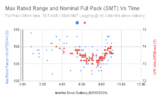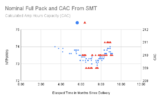At one point in time I would have disagreed with you. More recently, my NFP also jumped around, quite out of character with its previous tendency, which was showing a clear slope down (decreasing SoH). At the start of June, prior to a 700 Km road trip, after an AC L2 charge to 100% and then the same day a supercharge, the NFP went crazy (refer attached graphs). the changes aren't remotely as great as yours shown in the graph above. So, I'm left with a difficult decision of how to interpret the changes - tendency or just plain noise? BMS irrationality - firmware, my Breton roadtrip - who knows! The founder of SMT, (Amund Børsand) suggested I look at the CAC, but that's also a calculation so I can't get my head round that either. I appreciate that
@AAKEE told me to ignore minor changes but really, even if the overall change is no more than 1% NFP in my case it's quite weird

Alternative interpretations most welcome!
The BMS probably does a good job over all if we try see the big picture.
People here is probably more interrested in any little deviation and some pf us teads too much into changes in the NFP (specially decreasing NFP)
It seems like there is no coincidence that some changes in NFP comes after software updates of the cars. With Teslalogger and the software update dates it becomes quite obvious, and this also
I had a NFP at around 80.5-81 kWh not very long ago. I did one discharge down to around -2% to try to reset the BMS as I was sure my NFP was overestimated and my own capacity estimation said around 79kWh.
The “reset” worked and the NFP decreased to 79.2 kWh. Shortly After this I did drive down to 0% and than supercharged to 100%, still 79.2 indicated. I would guess that the real capacity is not very far from 79.
After an update a few weeks ago, the NFP dropped steady step by step to 77.0 kWh.
(During this time the car did much bigger cycles than normally due to some trips, and almost no small cycles at all.
I am sure that the real capacity
not will decrease 4 kWh / 5% during a short period so I am positive that this is BMS software related and maybe the changed usage have affected the NFP.
My guess is that the NFP will go up to around 79kWh, and I think the real capacity is somewhere around this.
My average SOC is around 40% and the average cell temp since september is 12C so the battery will not degrade fast.
Not at home (where my teslalogger data is available) so I can not post a picture of the very clear connection between the software and the change in NFP /range.
My collegue with a 80K km ‘19 LR reported that the range was suddenly “restored” to new car values from around 7-8% degradation which seemed to have happend at the same time as my drop.
I would not think that the NFP is on track on this car either.
Conclusion: the range/NFP values should not be taken as true as the can be all over the place.




